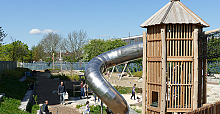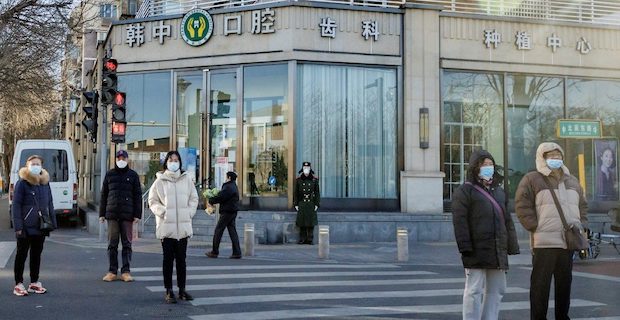People with Covid can now isolate at home rather than in state facilities if they have mild or no symptoms. They also no longer need to show tests for most venues, and can travel more freely inside the country. Citizens have expressed relief but also concern about the sudden changes. "Finally! I will no longer worry about getting infected or being taken away as a close contact," one person wrote on Chinese social media.
Another said: "Can anyone explain to me what's happening? Why is the change all of a sudden and so major?"
The sweeping changes indicate China is finally moving away from its zero-Covid policy and looking to "live with the virus" like the rest of the world. This comes as the country is grappling with its biggest wave of infections - over 30,000 each day.
Some users online have questioned the accelerated opening-up - "The medical system will be overwhelmed and many elderly would be infected. It begins now," one user wrote.
But many others rejoiced at the loosening of a policy that had controlled their lives for nearly three years.
Until now, China had forced people with Covid and anyone who was a close contact to go to quarantine camps. This policy had been deeply unpopular because it separated families and removed people from their homes..
Some of the centres were also reported to have poor living conditions and inadequate staff.
Videos all year have shown guards dragging people out of their homes after they refused to go. Viral footage from Hangzhou last week showed a man fighting off officials.
China's National Health Commissioned announced a swathe of other new freedoms on Wednesday. They said:
- They aimed to decrease testing. Lateral flow tests would replace PCR tests in most scenarios where a result is needed, although PCRs are still needed for schools, hospitals and nursing homes
- Lockdowns would continue but should only apply to more targeted areas - for example, certain buildings, units or floors as opposed to whole neighbourhoods or cities being shut down
- Areas identified as "high-risk" should come out of lockdown in five days if no new cases are found. Several cities in China have endured months-long lockdowns this year even when there were only a handful of cases
- Schools can remain open with student attendance if there's no wider campus outbreak
The new guidelines also included a strict ban on blocking fire exits and doors and said people had to be able to access emergency medical treatment and escape routes unhindered by pandemic measures.
It follows reports of people being locked into their homes during an earthquake, and buildings being sealed under lockdown measures.
The recent protests were triggered by a deadly fire in the western Xinjiang region - critics said the victims had been unable to escape the building because of lockdown measures but Beijing denies this.


 Prime Minister Keir Starmer's 2025 Easter message
Prime Minister Keir Starmer's 2025 Easter message After Nesil Caliskan a by-election will be held in Jubilee ward in Enfield
After Nesil Caliskan a by-election will be held in Jubilee ward in Enfield Publishing the analysis, Labour’s Cllr Ergin Erbil said Everybody in Enfield deserves basic rights
Publishing the analysis, Labour’s Cllr Ergin Erbil said Everybody in Enfield deserves basic rights Gaza-Israel conflict Statement from Cllr Ergin Erbil, Leader of Enfield Council
Gaza-Israel conflict Statement from Cllr Ergin Erbil, Leader of Enfield Council The European Union called on Turkey to uphold democratic values
The European Union called on Turkey to uphold democratic values Turkish citizens in London said Rights, Law, Justice
Turkish citizens in London said Rights, Law, Justice The Council of Turkish Cypriot Associations Geneva response letter
The Council of Turkish Cypriot Associations Geneva response letter Sustainable Development and ESG, Will This Become the Course for Turkic World
Sustainable Development and ESG, Will This Become the Course for Turkic World The 'Prince of Paris' has impressed in his first EuroLeague season
The 'Prince of Paris' has impressed in his first EuroLeague season Saran Media And Euroleague Basketball Extend Media Rights Partnership for Four More Years
Saran Media And Euroleague Basketball Extend Media Rights Partnership for Four More Years Will Rangers be Jose Mourinho’s next victim?
Will Rangers be Jose Mourinho’s next victim? Jose Mourinho's Fenerbahce face Rangers on Thursday
Jose Mourinho's Fenerbahce face Rangers on Thursday Barclays has become the biggest UK lender so far to cut mortgage rates
Barclays has become the biggest UK lender so far to cut mortgage rates THE SPRING STATEMENT EXPLAINED, UK ECONOMIC OUTLOOK AND GROWTH FORECASTS
THE SPRING STATEMENT EXPLAINED, UK ECONOMIC OUTLOOK AND GROWTH FORECASTS Launch of Made in Enfield gift shop to celebrate local artists and designers
Launch of Made in Enfield gift shop to celebrate local artists and designers Trial used smart Wi-Fi sensors for live building occupancy data to optimise
Trial used smart Wi-Fi sensors for live building occupancy data to optimise
















